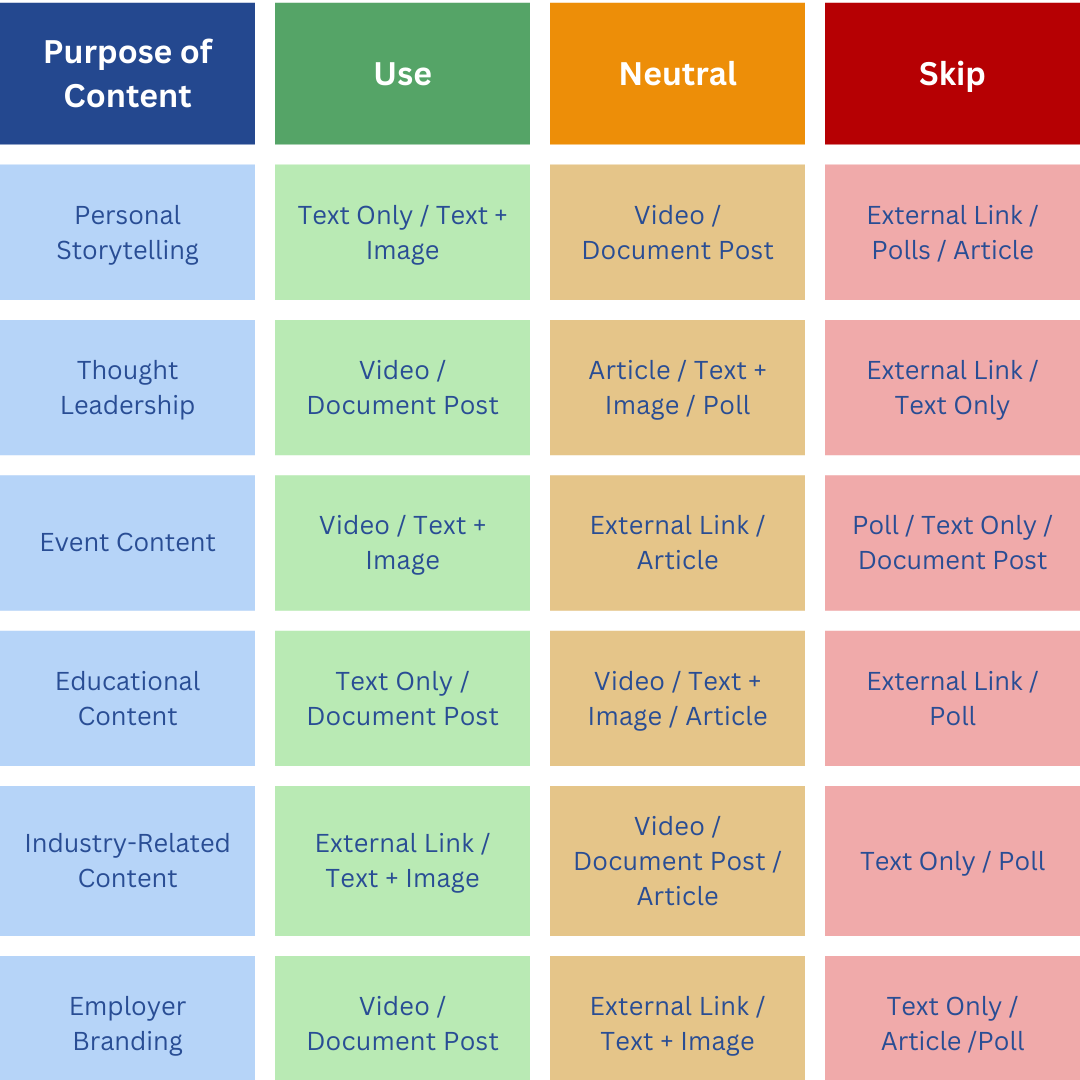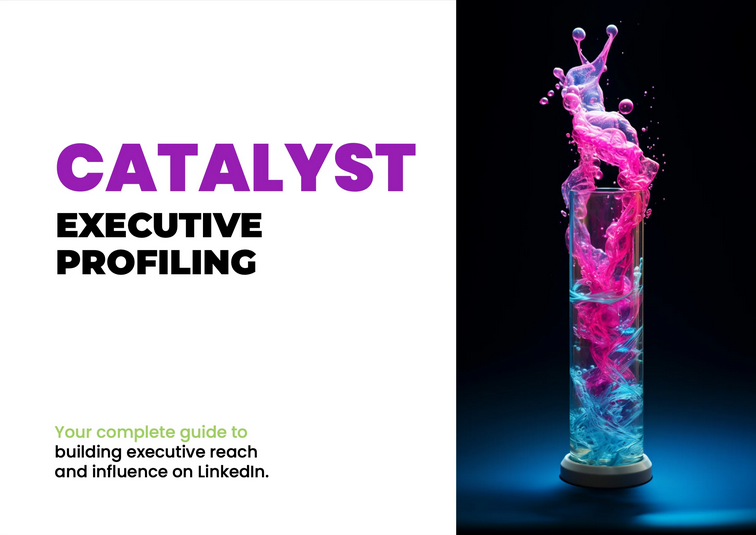
How to grow your LinkedIn Reach in 2024
Forget LinkedIn vanity metrics, focus on genuine engagement and embrace video in a mobile-first world
Last month saw the release of the illustrious and much anticipated Algorithm Insights 2024 report from LinkedIn™ trainer, Richard van de Blom.
If you’ve seen it, no doubt your head will be spinning with all the insights this report reveals, produced in partnership with LinkedIn™ posting platform AuthoredUp.
The reports’ authors analysed over 1.5 million posts from between November 2022 and November 2023 and the report totalled 123 pages. It’s packed full of insights from their analysis of posts from 34,000 individual profiles and over 26,000 company pages.
We have delved into the insights contained in this report to ensure best practice as we deliver our Catalyst personal branding service for business leaders on LinkedIn ™.
And so in this blog we thought we’d share the top 9 takeaways (well 10 when you include the shocker at the end!) that you need to know in 2024 when posting on the world’s leading business networking platform.
Table of Contents
- The number of LinkedIn™ members is up
- LinkedIn reach, engagement and follower growth are down
- Boost for Live video and LinkedIn™ events
- A mobile world favours portrait mode
- LinkedIn™ newsletters and articles remain critical
- Web links continue to reduce your reach
- Consistency is key but only once a day
- The engagement ‘golden hour’ still rings true
- Reposts – friend or foe?
1The number of LinkedIn™ members is up
The growth of LinkedIn™ has soared to 1,010 million members, with a surge of 120 million in the past year. This far outpaced the growth of other platforms such as Facebook and X (formerly Twitter).
LinkedIn reach, engagement and follower growth are down
Everyone’s reach, engagement and follower growth are down thanks to two tranches of LinkedIn™ updates over the year. When comparing November 2022 to November 2023 reach, the visibility of the average person’s post is down by more than 50 percent, and it’s the same with follower counts. Engagement is sitting at 58% of what it was in November 2022.
This means those chasing vanity metrics will be sorely disappointed. The report instead advises the goals you use for LinkedIn™ should instead be meaningful actions such as the quality of engagement, direct messages, inquiries, website visits with intent, and the number of scheduled demos.
The report includes this handy graphic, which outlines the different content types and how best to illustrate them to ensure you maximise your reach and engagement, based on the algorithm changes.

3Boost for Live video and LinkedIn™ events
The report highlights that LinkedIn™ members interacted with live video content 25 per cent more times than the previous year. As well as this, engagement with LinkedIn™ events has doubled indicating a shift towards real-time engagement and virtual networking.
As an aside, video in general trumps other content types when it comes to the amount of engagement you’ll receive on a post. And the ideal video length is now 1 minute and 20 seconds.
A mobile world favours the portrait mode
Users are more likely to view LinkedIn™ on a mobile phone (65% of members) over a desktop or laptop computer (35% of members). This has also had an impact on the best performing formats for imagery, graphics and video. When using a mobile phone, people are more likely to use it in portrait, and this means posts with carousels, video, graphics and photographs perform better if they are taken in portrait (vertical) mode rather than landscape (horizontal).
6Web links continue to reduce your reach
While including a web link in your post may appear the most straightforward method of sharing a link you’d like people to visit, you’ll likely see a 40-50% decrease in reach (personal) and a 25 – 35% (company page) reduction in visibility compared to a standard text post with an image.
However, LinkedIn™ is also now hiding comments as irrelevant where people have tried to circumvent this reach reduction by sharing a link in the comments.
Because of this, the report recommends only including a link when you need to drive external engagement such as to sign up for an in-person event. Alternatively, you could post and then go in and edit your post. This won’t reduce your post’s reach. However, you run the risk of forgetting to edit it (if you’re like me at any rate!), particularly if the post was scheduled rather than posted live.
Consistency is key but only once a day
The report reveals that the optimum time to post is between 8am and 11am. The key here is consistency though because the algorithm picks up on the regularity of your posts and you’ll see a boost to your LinkedIn reach and engagement by posting at a similar time each day. Don’t post more than once a day from a personal profile or you’ll split your reach between the two posts (this doesn’t apply to company pages).
However, the report also highlights that LinkedIn™’s algorithm tracks the engagement of your last 10-15 posts. If your content consistently receives low engagement, LinkedIn™ may decrease the visibility of your future posts.
The engagement ‘golden hour’ still rings true
Early engagement sets the momentum for your post’s visibility in the next six hours. This means you should aim to respond to everyone who comments on your post within that first hour (and it’s just plain courtesy surely!). Regular engagement with your post over the next six hours is also important for the continued reach of your post.
9Reposts – friend or foe?
The report showed that there is greater benefit for the original poster than there is for the person who reshares a post on LinkedIn™. The benefits are greatest for both when the post is simply reshared, rather than with thoughts added. However, for the reposter it still stands that creating original content rather than reposting is much more effective in building their LinkedIn™ profile. In fact, for the reposter, a ‘repost with thoughts’ is the equivalent to the reach they would gain by liking just two posts. Whereas reposting without thoughts will give them the equivalent visibility of liking five posts. Additionally, the LinkedIn™ algorithm considers ‘reposting with thoughts’ as fresh content for the reposter, meaning that the reach on any original content they post within the same 24 hours could be impacted negatively.
And the shocker…
And finally… the biggest shocker of all for those of us who loved a hashtag is that hashtags no longer significantly boost your post’s visibility on LinkedIn™. While they might still offer some benefit for searchability, the time you spend finding the right hashtags won’t yield the results you’re after. Whether or not you use them now comes down to personal preference.
The release of the Algorithm Insights 2024 report unveils important learnings for maximising your reach and engagement on LinkedIn™. While organic reach and follower growth may be down, there’s a silver lining and that is a shift towards genuine engagement and relationship building.
For me, when you’re looking to grow your LinkedIn reach, it means you should continue to focus on quality content, embrace both video and live events, and remember, consistency is key. Engage early and strategically and adapt to the platform and its users’ evolving preferences such as mobile-first viewing and taking note of the diminishing impact of hashtags.

Discover what six senior leaders who have embraced social and learned from their experience – watch our webinar and grab our exclusive report “Leaders on LinkedIn”

Discover how we use LinkedIn to grow influence
Our proven, white glove approach to building senior executive reach and influence on LinkedIn.

